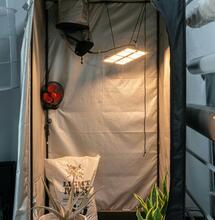Grow Vertical? Pros and Cons

Vertical growing systems look like something out of a sci-fi film, in-fact some are actually used by NASA. They’re ingenious and a real sign of how progressive indoor growing can be. If you’re an experienced grower who is lacking in floor space, they might just be worth considering. In this article, let's see the pros and cons of vertical cannabis grow systems.
What is Vertical Growing?
At its most basic, stacking a few plants around the edge of your horizontal grow room to soak up the spare light is an effective method of vertical growing. But in this instance, we are talking vertical systems.
There are a number of specific vertical growing systems on the market, which involve positioning the plants in a 360-degree formation around two grow lights; usually encased in a cool tube with no reflectors. The idea is to maximise the height in the grow room, rather than the floor space. This is done by hanging the lights vertically and using all of the available light energy. Plants are ‘stacked’ around the lights, usually in rock wool cubes. To pull the maximum amount of yield from the available light and space, very high plant numbers are used. Plants are kept very short, vegged for only a few days and then flowered.
Think of it as sea of green growing, with the lights hung in the middle of a cylinder of plants. Used successfully, incredible yields are possible.
The Pros and Cons
Pro #1 - Yield
The whole concept of the vertical growing system hinges on that fact that the grower is able to pull more yield per light than if they were growing horizontally. Although when the systems first hit the market in the UK there were some ridiculous claims flying around; like an ounce per plant from a 140 plant system, not exactly realistic! Have a look around some of the more popular growing forums online and there are a few experienced growers using the vertical systems that are maxing out at 50-70 ounces per crop from two lights – that’s pretty incredible given that the veg time is only two or three days and the system fits in a 1.5m square tent.
Con #1 - Cost
Compared to a regular horizontal growing system (or even a top of the range horizontal system), the vertical grow systems are fairly expensive. The smaller units that could fit around 80 plants or more can cost above £1000, while larger 200 plant versions may be double the price. Yes, you do get grow lights in the price. But, it still can be a hell of a chunk of change. Plus, there might be extra costs for equipment maintenance, humidity control system, or preferable nutrients to use with vertical grow setups.
Pro #2 - Easy to set up
The better, more expensive, vertical systems are almost ‘plug and play’ and can be set up in less than an hour. Some of the models on the market even come with their own grow tent! The lights, rock wool slabs and drip irrigation lines are already integrated into the system, all the grower needs to do is rig up a filter and extraction system in their room, fill up the nutrient reservoir and add their plants, which leads us onto...
Con #2 - Time consuming to fill
One thing that you have to think about if you’re considering using a vertical system is the time and effort it takes to propagate those extra plant numbers and then physically put them into the grow room. The smaller systems on the market are optimised for around 80 plants. So, if you follow the rule with cuttings that you take an extra 20% and only pick the strongest plants to grow on, you’re taking 96 cuttings and propagating them! A lot of work... and that’s just for the small vertical system!
Pro #3 - Extra crop cycle per year
This is a huge positive for the vertical systems and, for many growers, it’s the reason that they buy one in the first place. Once they are propagated, plants going into a vertical system only need to be vegged for two to three days before they can be switched to flower. Most growers will be used to vegging their plants for around two to three weeks. If you’re not operating separate veg and flower rooms, this massively shorter veg period would allow you to squeeze an extra crop in each year! That expensive vertical system has just paid for itself!
Con #3 - Extra plant numbers
Without wanting to piss on anyone’s campfire, whenever you’ve got a grow on the go, it’s always worth having a little think about the worst case scenario.... what if the door comes in? If you’ve got 140 plants under 20 lights, it’s pretty cut and dry that you’re going to get the ‘book thrown at you’ (and you’re probably well aware of that). If you’ve got eight big plants under two lights, you’ve got a pretty good case to argue that you’re growing for yourself. How would plod view 140 plants grown under two lights? You don’t need to be a legal expert and to know that, if the long arm of the law intends to clamp down on growers depending on plant numbers only... this sounds like a recipe for disaster!
Pro #4 - Better use of space and electricity
The vertical system allows you to run a successful two light grow room within a comparatively small area. For example, a regular (horizontal) two light room would usually cover a space measuring 2.4m x 1.2m, where let’s say each 600w light is used to cover a growing area of 1.2m square. The smaller vertical systems operate within a space covering 1.35m square - although realistically they’d probably be utilised within a 1.5m square grow tent. The vertical system is designed to produce more yield than a two light horizontal grow and it will use less electricity. Plants are only vegged under 18 hours light for a couple days compared to a longer period with a horizontal grow. This could save some serious cash on electricity.
Con #4 - Need more mother plants
Although it’s certainly correct that a vertical system uses space and electricity more efficiently than a horizontal grow, it does require far more plants and - unless you’re willing to buy large quantities of cuttings - these young plants need to be provided by mother plants. If you have 80 plants going into a vertical system, you will need at least two decent sized mother plants to provide for them. These mother plants need additional space and lights and your 80 cuttings need to be propagated - this requires extra space and electricity.
Pro #5 - Efficient use of light
This is where the vertical system plays its trump card over horizontal grow set ups! Plants surround the lamps 360 degrees, there is no loss of efficiency from bouncing light off a reflector back onto the canopy - all of the plants in the system receive an equal amount of light and are kept close to the source, so there is reduced loss of light. The bulbs are housed in ‘cool tubes’ with the heat being extracted away, allowing the plants to get nice and close to that intense light.
Con #5 - You have to use cool tubes
Cool tubes are a great product and - for very small grow rooms or rooms running lots of lights - they can be the only option to run HID lighting. However, they do have their downsides. Compared to an ‘open’ reflector, the curved glass in a cool reduces the amount of available light that reaches the plant. Also, glass will block out the UV light that reaches a plant and it is UV that causes the plant to put out lovely essential oils.

Top Tips for Vertical Systems
Now that we’ve seen the pros and cons for cannabis vertical grow, let’s take a look at some key tips that are good to consider if you’re ever going to grow this way.
1. Select the right strain
Vertical growing relies on growing small, squat plants, so it is essential to choose a strain that stays short and stocky, with very tight internodes. The last thing you want is lanky, leafy plants that stretch out before they are fully flowered.
2. Practice with the strain
When using a vertical system, there is very little margin for error and it takes a fair amount of effort (and plants) to restart a grow. So it’s really important to have some first-hand experience with growing your chosen strain in a regular horizontal grow. This way you’ll know what to expect at each stage of the cycle. For example, the veg stage is very short so you need to pick a strain that roots fast and isn’t too susceptible to transplant shock. When the plant is switched to flower, you need a strain that doesn’t stretch too much and can be pruned into a small single cola.
3. Keep cuttings uniform
With space between each plant being very tight, it’s easy for taller plants to block out all the available light to the plants next to it. To prevent this happening, you must ensure that the cuttings that you propagate to go into the system are the same size. This means - as stated earlier - that you need to take more cuttings than you need, propagate them and select the ones that are most uniform in size.
4. Propagate until roots are bursting
With such a short veg period - two to three days, at most - you must ensure that your cuttings have roots bursting out of their starter media before they go into the slabs. You need them to take straight away and don’t want to be hanging around for them to root out.
5. Use a slab with a multi directional weave
Some makes of rock wool slabs are specifically designed to be used horizontally, the actual wool is weaved horizontal to ensure nutrient dripped into the slab is dispersed evenly and there is an equal amount of resistance to the roots as they fill the slab. When you’re using a vertical grow system, make sure you use a slab with a multi-directional weave, otherwise plants at the bottom of the slab won’t receive enough feed.
6. Maintain your temperature
If your plants stretch in the system, you will end up with more leaf than bud! The key to cultivating short, stocky plants is maintaining a consistent temperature - not just during lights on, but also when lights are off. Invest in a smart system or max/min thermometer to record your high and low temperatures. Large fluctuations can cause your plants to stretch or the canopy to become uneven. If necessary, increase your extraction during lights on and utilise an oil heater in the room during lights off. Keep your ‘day’ and ‘night’ temperatures close and your plants will remain short.
7. Use a very clean mineral nutrient
Vertical grow systems available on the market typically feed plants using drip irrigation, and with the cannabis plants only being in the system for 8-10 weeks, you want to make it through the grow without having to deal with any blocked lines. It would be a huge pain in the arse to have to take the system apart a few weeks from the end because a drip line is blocked. Use a 100% mineral nutrient and avoid using thick, gloopy flowering stimulators. Investing in a line cleaning additive will also keep things running nice and clean.
8. Extraction, extraction, extraction
When you’re packing a space with multiple plants it’s really important to keep your humidity in check, especially when you’re plants are flowering. Multiple plants, growing closely together in an environment with little air flow and high humidity is a sure-fire recipe for powdery mildew and botrytis (aka the dreaded bud rot!). There’s nothing worse than getting to the end of a successful grow and losing half of your buds because they’ve rotted away. Extraction is key when using vertical systems, make sure that you are replacing the air in the room at least once a minute and get a clip fan blowing across the canopy to prevent any pockets of stale air from getting trapped amongst the foliage.
9. Be confident
To invest some of your hard-grown money into a vertical system, you must be confident in your own growing abilities. Now don’t let those plants get out of hand! Take control, show them who is boss and enjoy yourself!
Happy growing!
More from Soft Secrets:



.png)











